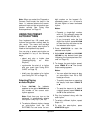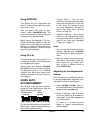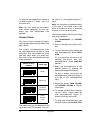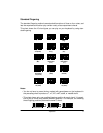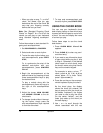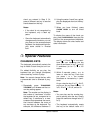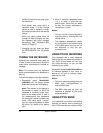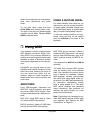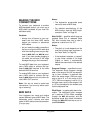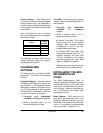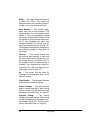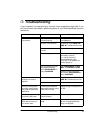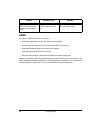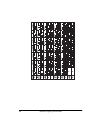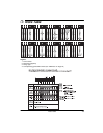
22
Using MIDI
MAKING THE MIDI
CONNECTIONS
To connect your keyboard to another
MIDI-equipped device, you must use a
MIDI cable (available at your local Ra-
dioShack store).
Cautions:
• Always turn off power to your key-
board and the other MIDI device
before you connect or disconnect
MIDI cables.
• As you make the cable connections,
be sure to align the MIDI cable pins
with the matching holes on your key-
board’s
MIDI OUT
and
MIDI IN
termi-
nals. If you have trouble plugging in
the cable, do not force it! You might
damage the plug or the instrument.
To send MIDI data from your keyboard,
use a MIDI cable to connect the key-
board’s
MIDI OUT
terminal to the other
device’s MIDI IN terminal.
To receive MIDI data on your keyboard,
use a MIDI cable to connect the key-
board’s
MIDI IN
terminal to the other de-
vice’s MIDI OUT terminal.
Note:
You do not need to make both
connections if you are only either send-
ing or receiving.
MIDI DATA
Your keyboard can send and receive
several different types of MIDI data. The
keyboard’s tones, rhythms, and other
types of MIDI data are sent automatical-
ly as you play.
Notes:
• The keyboard’s prerecorded tunes
cannot be sent as MIDI data.
• For detailed specifications of the
MIDI function, see the “MIDI Imple-
mentation Chart” on Page 30.
Note On/Off
—
specifies which keys are
pressed (Note On) or released (Note
Off). Also includes how loud a note is
played as a value from 0 to 127.
Notes:
• The pitch of a note depends on the
tone that is being used, as shown in
the “Note Table” on Page 29.
• If the keyboard receives a “request”
to play notes outside of its range
(higher or lower), it automatically
selects the same note in the nearest
octave.
Program Change
—
specifies the tone.
The keyboard sends program change
data in the range of 0 to 99, correspond-
ing to tone numbers. It receives data
within the same range if GM tone map-
ping is set to N, or in the range of 0 to
127 if GM tone mapping is set to G. In
the latter case, tones in the range of 100
to 127 are translated to the closest tone
that the keyboard has.
Pitch Bend
—
supplies pitch bend infor-
mation. The keyboard’s pitch changes
as it receives a Pitch Bend message
through the
MIDI
IN
terminal, and the
keyboard sends pitch bend information
through the
MIDI OUT
terminal as you ro-
tate
PITCH BEND
.



